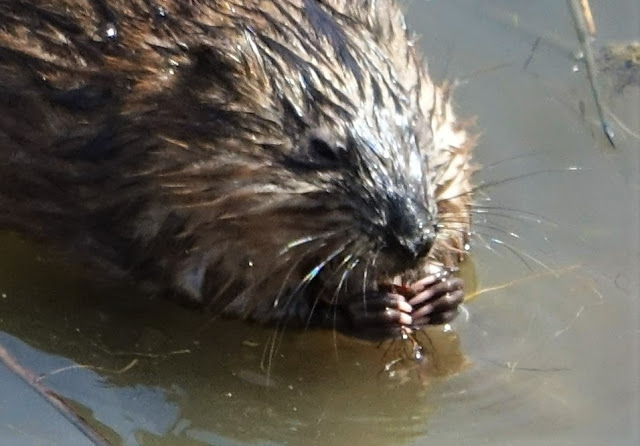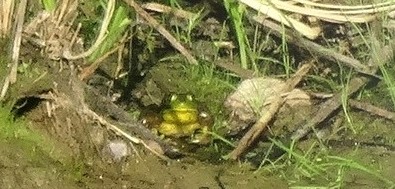6/22/2023
two killdeers
4/29/2023
muskrat, greener pastures
4/12/2023
muskrat claws
The muskrats Ondatra zibethicus who live on the pond are semi-aquatic rodents.
They eat mostly plant matter, but also smaller critters that they find. To eat, they have a thumb and four fingers -- with claws -- to grasp food. The back feet are larger and have five webbed fingers that help swimming in ponds, lakes, and rivers. They swim under water hunting for vegetation that they gnaw and chew with large incisor teeth located in front of their cheek. Or, they may sit on shore chewing terrestrial grasses.
4/09/2023
first turtle of Spring
Adult painted turtles Chrysemys picta begin active foraging usually in March or early April. Since winter has held on strongly until now, we only saw the first turtle today when the sun was shining and temperature is in the 60's F.
Shortly after awaking from winter, courtship begins. If they laid clutches of eggs last fall, the little hatched turtles probably over-wintered in the nest. Now they emerge and instinctively seek the security of water in the pond.
Today, the Spring Peepers are singing too!
11/01/2022
tamarack in autumn
The Tamarack tree Larix laricina is a deciduous tree. In summer it has lush green needle-like leaves; in autumn the leaves turn golden before they drop. Next to the pond, it gets along with other swamp and wetland species.
This tree is also a conifer, making small cones that shed winged seeds in the fall.
9/20/2022
9/18/2022
9/08/2022
very green heron
9/05/2022
scouring rush 'horsetail'
Scouring Rush Equisetum hyemale grows in the wetland around the pond.
It is also called 'horsetail'. This plant has coarse fibers and silica deposits in its stems, so herbivores don't eat this plant.
For more about this plant, see blog posts on 7/23/2020 and 6/25/2021.
9/03/2022
baby snapping turtle
We found this baby Snapping Turtle on a street curb in the neighborhood. We relocated it to the wetland around the pond, hoping it would find enough to eat there. Snapping Turtles Chelydra serpentina eat water plants as well as insects, worms, snails, small fish, and anything edible that it can find.
7/27/2022
tiny toad
On a patch of gravel a toad, the size of a quarter coin, was hunting for breakfast among the spider webs.
7/22/2022
vervain
7/10/2022
green frog looks like . . .
7/08/2022
7/07/2022
culver's root
7/03/2022
mallard families
Female Mallard came out of the grasses with her 3 young ducks (upper right). Then, another Mallard appeared with her 8 younger ducklings. They were all intent on eating duckweed and other aquatic plants growing in the pond.
6/19/2022
6/11/2022
iris
6/08/2022
blackbird nest
The Red-winged Blackbird Agelaius phoeniceus gave away the secret location of their nest by screeching at us as we walked around the pond. As I came near the spot, he warned me vocally and hit my hat with his feet as he flew by.























